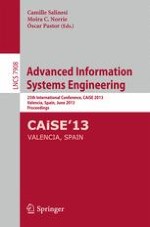This book constitutes the refereed proceedings of the 25th International Conference on Advanced Information Systems Engineering, CAiSE 2013, held in Valencia, Spain, in June 2013.
The 44 revised full papers were carefully reviewed and selected from 162 submissions. The contributions have been grouped into the following topical sections: services; awareness; business process execution; products; business process modelling; modelling languages and meta models; requirements engineering 1; enterprise architecture; information systems evolution; mining and predicting; data warehouses and business intelligence; requirements engineering 2; knowledge and know-how; information systems quality; and human factors.
